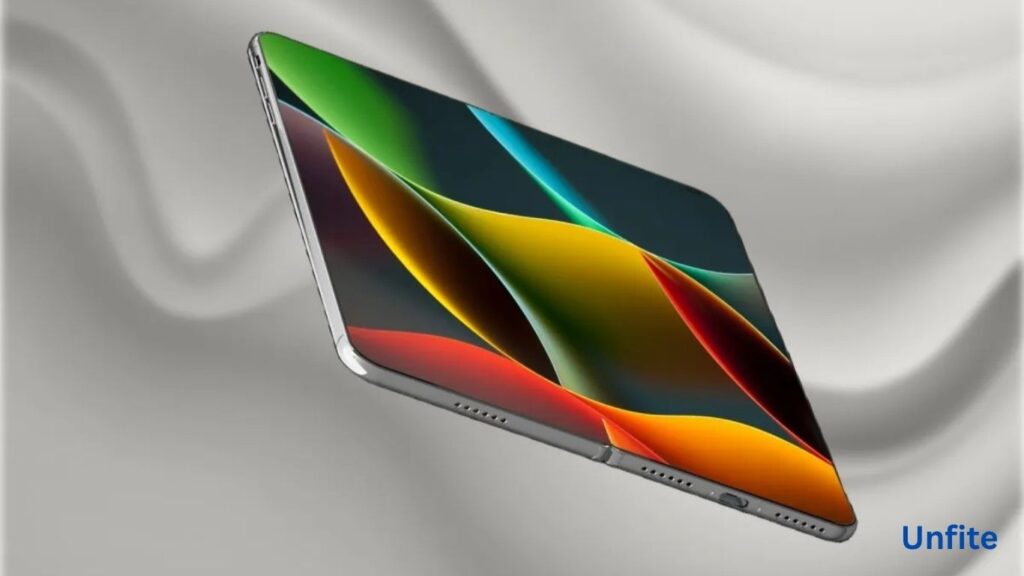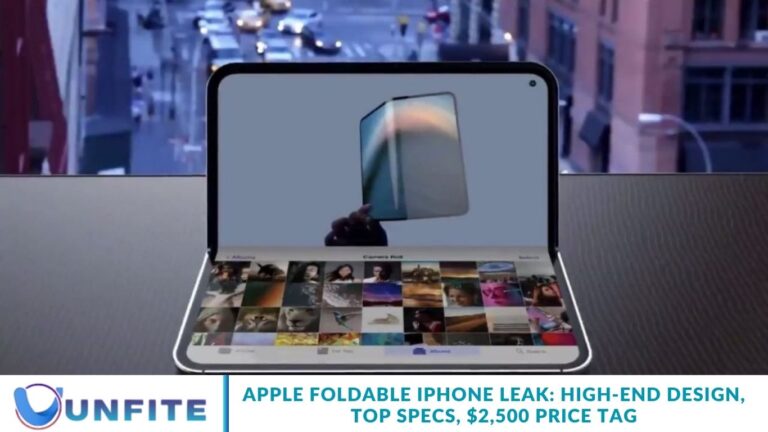Rumors surrounding Apple’s first foldable iPhone have circulated for years, and now new insights from renowned analyst Ming-Chi Kuo shed light on its design, features, and expected pricing. Unlike many current foldable phones from competitors, which focus on AI features and book-style folding, Apple appears to be taking a unique, premium-first approach with cutting-edge hardware.
In this article, we’ll explore everything we know so far about the Apple foldable iPhone—including its expected design, specs, innovative features, estimated price, and possible release date.
Expected Features and Specifications
| Feature | Specification |
| Name | Apple Foldable iPhone (First-Gen) |
| Display Size | 7.8-inch inner screen, 5.5-inch outer screen |
| Display Type | Crease-free OLED |
| Primary Camera | Dual-lens rear camera |
| Selfie Camera | Front-facing camera (both modes) |
| Processor | Likely Apple A19 or M-series chip |
| Software | iOS with Al-driven enhancements |
| Battery | High-capacity battery, fast charging |
| Security | Touch ID (side button) |
| Build Material | Titanium alloy with stainless steel hinge |
| Price Range | ₹1,65,000 – ₹2,00,000 |
| Release Timeline | Late 2026 (mass production) |
Design and Display
According to recent reports, Apple’s foldable iPhone is expected to adopt a book-style folding design, similar to the Samsung Galaxy Z Fold series. However, Apple aims to solve one of the most significant issues plaguing current foldables: the display crease. The device is rumored to feature a 7.8-inch inner display with no visible crease and a 5.5-inch outer display for quick access while folded.
When closed, the foldable iPhone will reportedly measure 9–9.5mm in thickness and just 4.5–4.8mm when unfolded, making it one of the thinnest foldable smartphones in development. To support this sleek profile, Apple will likely use a titanium alloy and stainless steel hinge, balancing durability with a premium aesthetic.
Camera and Security Features
The upcoming foldable iPhone is expected to sport a theater-style dual-lens rear camera system designed to deliver high-quality photography in both folded and unfolded modes. While the exact megapixel count remains unknown, Apple is likely to incorporate its latest computational photography advancements and AI-powered camera features for superior image processing.
Due to space limitations in the foldable design, Apple may skip Face ID in favor of Touch ID integrated into the side button, similar to what we’ve seen in the iPad Air and iPad mini. This approach maintains strong security while optimizing internal space for a more compact and efficient foldable form factor.
AI-Driven Functionality
The upcoming foldable iPhone marks a significant milestone in the evolution of foldable smartphones, and Apple plans to position it as a “truly AI-powered device.” With advanced multimodal capabilities and deep app integration, the foldable iPhone is expected to deliver seamless AI functionality across the entire user experience.
Examples of potential AI features include:
- Conversing with AI while navigating in Apple Maps
- Inserting AI-generated text into emails and messages
- Real-time translation through AI-powered language processing
This move highlights Apple’s growing investment in machine learning and on-device intelligence and its broader goal of creating an innovative, intuitive ecosystem powered by next-gen AI technology.
Apple Foldable iPhone Price: Justified or Overpriced?
As with any groundbreaking innovation, pricing remains a hot topic. The Apple foldable iPhone is rumored to be priced between ₹1,65,000 and ₹2,06,000, making it one of the most premium smartphones ever released. At this price point, it would surpass even the Samsung Galaxy Z Fold 5, which currently retails at $1,799 (approx. ₹1.49 lakh). This premium pricing reflects Apple’s strategy to position the device as a luxury foldable phone with cutting-edge technology and exclusive features.

Why is it so expensive?
- Durability: The foldable iPhone is expected to offer exceptional durability, as it is made of titanium alloy and stainless steel— but this also significantly increases production costs.
- Display Technology: A crease-free OLED display—though expensive and difficult to manufacture—offers a premium, high-performance viewing experience, making it ideal for advanced foldable devices.
- Brand Loyalty and Ecosystem Integration: Apple’s products often carry a premium price tag due to strong brand loyalty and seamless integration within its ecosystem of devices and services.
- AI Innovation: Apple’s advancements in artificial intelligence could introduce exclusive, intelligent features that make the foldable iPhone stand out in a competitive market.
- Market Demand: Despite the high price, Apple’s loyal customer base, especially early adopters and tech enthusiasts, is likely to drive strong demand for the foldable iPhone.
Production and Launch Timeline
According to renowned analyst Ming-Chi Kuo, Apple is expected to finalize the specifications of its first foldable iPhone by Q2 2025, with the project officially kicking off in Q3 2025. Mass production is likely to begin in Q4 2026, with the first batch of devices expected to launch in late 2026 or early 2027.
Apple plans a limited rollout, targeting 3–5 million units in the first year. However, with the expected launch of the second-generation foldable iPhone in 2027, production could scale significantly—potentially reaching up to 20 million units annually as Apple expands into the foldable smartphone market.
Potential Challenges for Apple
- The delicacy of the Display: Foldable screens are inherently fragile, so Apple must ensure top-tier durability before mass production to maintain long-term reliability.
- Limited iOS Multitasking: iOS currently lacks advanced multitasking features needed to fully utilize the benefits of a foldable display.
- High Price Barrier: With an expected price tag of $2,500, the foldable iPhone may be too expensive for mainstream users, limiting its initial adoption.
- Battery Life Concerns: Foldable displays consume more power, so Apple must balance thin design and battery capacity to ensure all-day performance.
Frequently Asked Question
What is the expected release date for the Apple foldable iPhone?
According to reports, Apple may unveil its first foldable iPhone in late 2026 or early 2027, with mass production starting in Q4 2026.
How much will the foldable iPhone cost?
Leaks suggest the foldable iPhone will cost around $2,500, making it one of the most expensive smartphones Apple has ever released.
What type of display will the foldable iPhone feature?
The device is rumored to use a crease-free OLED display, offering a 7.8-inch inner screen and a 5.5-inch outer screen engineered for a seamless visual experience.
Will the foldable iPhone support Face ID?
Due to space constraints, Apple might replace Face ID with Touch ID integrated into the side power button, similar to the iPad Air and iPad mini.
How durable will the foldable iPhone be?
Apple is said to be using titanium alloy and stainless steel for enhanced durability and a strong hinge mechanism.
What kind of camera system will it have?
The foldable iPhone is expected to include a dual-lens rear camera optimized for both folded and unfolded modes, powered by AI-driven computational photography.
Will the foldable iPhone run iOS or a new OS?
It will likely run a version of iOS customized for foldable screens, although Apple may introduce new multitasking features to match the foldable experience.
Conclusion
Apple’s foldable iPhone is shaping up to be one of the most exciting innovations in the smartphone world. With a crease-free 7.8-inch OLED display, durable titanium build, and AI-driven features, it promises to blend cutting-edge tech with signature Apple elegance. Priced around $2,500, it’s clearly aimed at early adopters and premium users. The device may swap Face ID for Touch ID on the side to save space and improve the form factor. Expected to launch by late 2026 or early 2027, the first batch will likely be limited in quantity. Apple is positioning this phone as a next-gen experience that competes directly with top-tier foldables like Samsung’s Galaxy Z Fold. If successful, it could redefine what users expect from the future of foldable smartphones.


